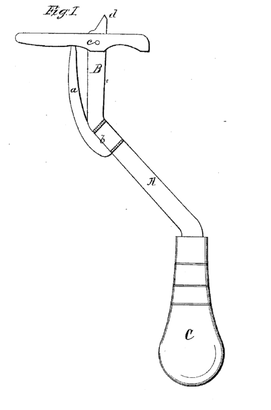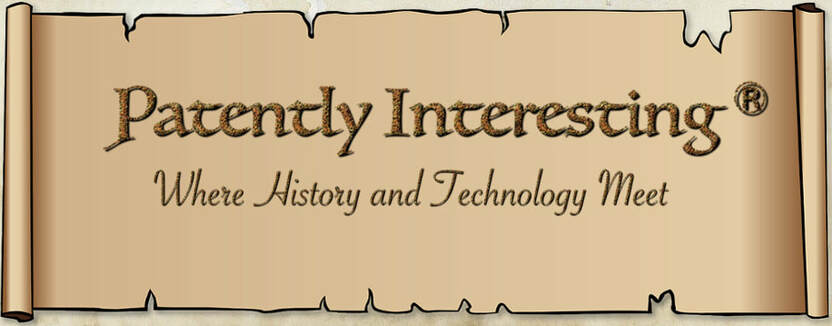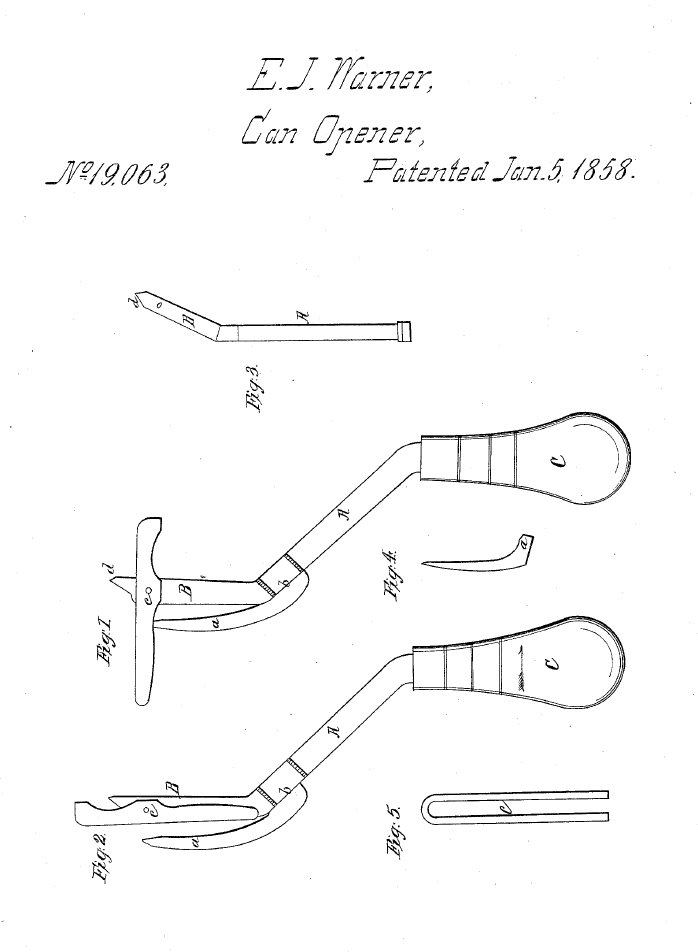On January 5, 1858, U.S. Patent No.: 19,063 issued to Ezra J. Warner of Waterbury, Connecticut. It was the first patent to issue for a can opener. At the time, sealed metal cans were already widely used for storing and preserving food. Indeed, a British merchant, Peter Durand, had received a British patent in August of 1810 for preserving food in a tin can. In the 1820s, the explorer, Sir William Edward Perry, brought tins filled with food on his expeditions to the arctic in search of the Northwest Passage. One of these tins, filled with roastd veal, was saved for posterity, remaining unopened for more than 100 years. When the tin was finally opened in 1938, the veal was so well-preserved it was fed to a cat, who thoroughly enjoyed the century old meat.
It is rather surprising that it took almost 50 years after the invention of the tin can for someone to invent a device that could open one without too much trouble. Up until Warner's invention, however, tin cans were typically opened using a hammer and chisel, which often resulted in the contents of the can being sprayed over the person opening the can. The use of a hammer and chisel was most likely necessitated by the use of thick can ends, which became thinner over time and probably inspired Warner's invention. Regardless of its inspiration, Warner's can opener was the first of its kind and quickly achieved commercial success, particularly during the U.S. Civil War.
It is rather surprising that it took almost 50 years after the invention of the tin can for someone to invent a device that could open one without too much trouble. Up until Warner's invention, however, tin cans were typically opened using a hammer and chisel, which often resulted in the contents of the can being sprayed over the person opening the can. The use of a hammer and chisel was most likely necessitated by the use of thick can ends, which became thinner over time and probably inspired Warner's invention. Regardless of its inspiration, Warner's can opener was the first of its kind and quickly achieved commercial success, particularly during the U.S. Civil War.
 Warner Can Opener
Warner Can Opener
Warner's can opener included a shank (A) with a piercer-bar (B) having a pointed tip (d). A curved cutter (a) was fastened to the shank (A) and was spaced from the piercer-bar (B). A loop bar or guard (c) was pivotably attached to the piercer bar (B). To open a can, the pointed tip (d) was first pierced through an end or other part of the can. The opener was then turned over and the cutter (a) inserted into the piercing. With the guard (c) held against the end, the cutter (a) was sawed around the periphery of the end, thereby opening the can.
The '063 patent asserted that "The advantages of my improvement over all other instruments for this purpose consist in the smoothness and rapidity of the cut, as well as the ease with which it is worked, as a child may use it without difficulty or risk....." Notwithstanding this assertion, Warner's can opener could be dangerous to use and was not sold to domestic consumers. Instead, it was sold to grocers who would use the implement to open cans for customers before they left the store.
The '063 patent asserted that "The advantages of my improvement over all other instruments for this purpose consist in the smoothness and rapidity of the cut, as well as the ease with which it is worked, as a child may use it without difficulty or risk....." Notwithstanding this assertion, Warner's can opener could be dangerous to use and was not sold to domestic consumers. Instead, it was sold to grocers who would use the implement to open cans for customers before they left the store.


